8 Most Frequently Asked Questions About Outlook

Table of contents
Microsoft Outlook is an email application which is primarily used to send and receive emails. It also offers other functionalities such as a calendar, task management, and contact organization.
It can be used as a standalone application or as part of the Microsoft 365 suite of applications, which includes Word, Excel, PowerPoint and so on.
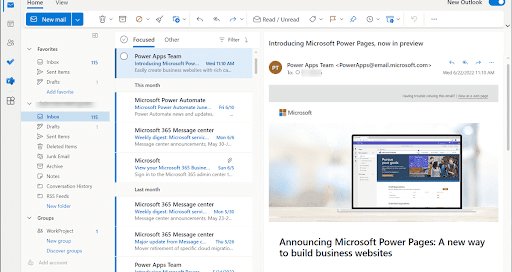
40% of all email users use Outlook for their email management needs. With such a large user base, it’s only common for Outlook users to have questions and doubts on how to navigate the service and use its features.
In this article, we’ll be addressing the most commonly asked questions about MS Outlook.
Let’s dive right in.
Table of Contents
- 8 Most Frequently Asked Questions About Outlook
- 1. How are Outlook and Outlook 365 different from each other?
- 2. How do I unsend an email in MS Outlook?
- 3. Can I recover deleted emails in Outlook?
- 4. How do I share my calendar on Outlook?
- 5. How to add a signature on MS Outlook?
- 6. How do I create a contact group in outlook?
- 7. How can I add or remove members from an existing contact group in Outlook?
- 8. What is a Shared Inbox in Outlook and how does it work?
- Conclusion
8 Most Frequently Asked Questions About Outlook
Here are the 8 most frequently asked questions about Outlook, along with solutions –
1. How are Outlook and Outlook 365 different from each other?
Users purchase Outlook as a one-time license, allowing them to own that version forever but without access to future updates beyond essential security and maintenance. Installed locally on a computer, Outlook enables offline access to email, calendar, contacts, and tasks, catering to users who prefer a traditional, single-purchase model for their software.
Outlook 365 on the other hand, is a part of Microsoft 365, a subscription-based service that offers continuous updates and new features. This version of Outlook is deeply integrated with other Microsoft 365 services such as OneDrive, SharePoint, and Teams, enhancing collaboration and cloud-based functionalities. Subscribers can use Outlook 365 on multiple devices, including PCs, Macs, tablets, and smartphones, with data synced across all platforms.
| Point of comparison | Outlook | Outlook 365 |
|---|---|---|
| Cost | Free (with limited features) | Basic plan starts at $6/month/user |
| Access | Web browser only | Desktop app & Web browser |
| Offline availability | No | Yes |
| Integration | Limited integration with other services. | Seamless integration with other Microsoft 365 apps and services (Word, Excel, PowerPoint, OneDrive, etc.). |
| Storage | Depends on the version; typically limited by the device’s storage. | 50 GB mailbox storage per user, 1 TB OneDrive storage. |
| Features | Basic email, calendar, and contacts management. | Includes all features of Outlook plus access to Office apps, Teams, and other Microsoft 365 services. |
| Security | Local security measures; relies on device’s security setup. | Advanced security features, including data loss prevention, encryption, and threat intelligence. |
| Support | Limited support based on the purchased version. | 24/7 customer support included in the subscription. |
2. How do I unsend an email in MS Outlook?
In Outlook, the ability to unsend an email is available through the “Recall” feature, but it has specific conditions and limitations. This feature allows you to recall (unsend) or replace an email that you have sent. Here’s how to use it:
- Go to your “Sent Items” folder and double-click on the email you want to recall to open it in a separate window.
- In the open email window, go to the “Message” tab on the toolbar, then click on the “Actions” group, and select “Recall This Message.
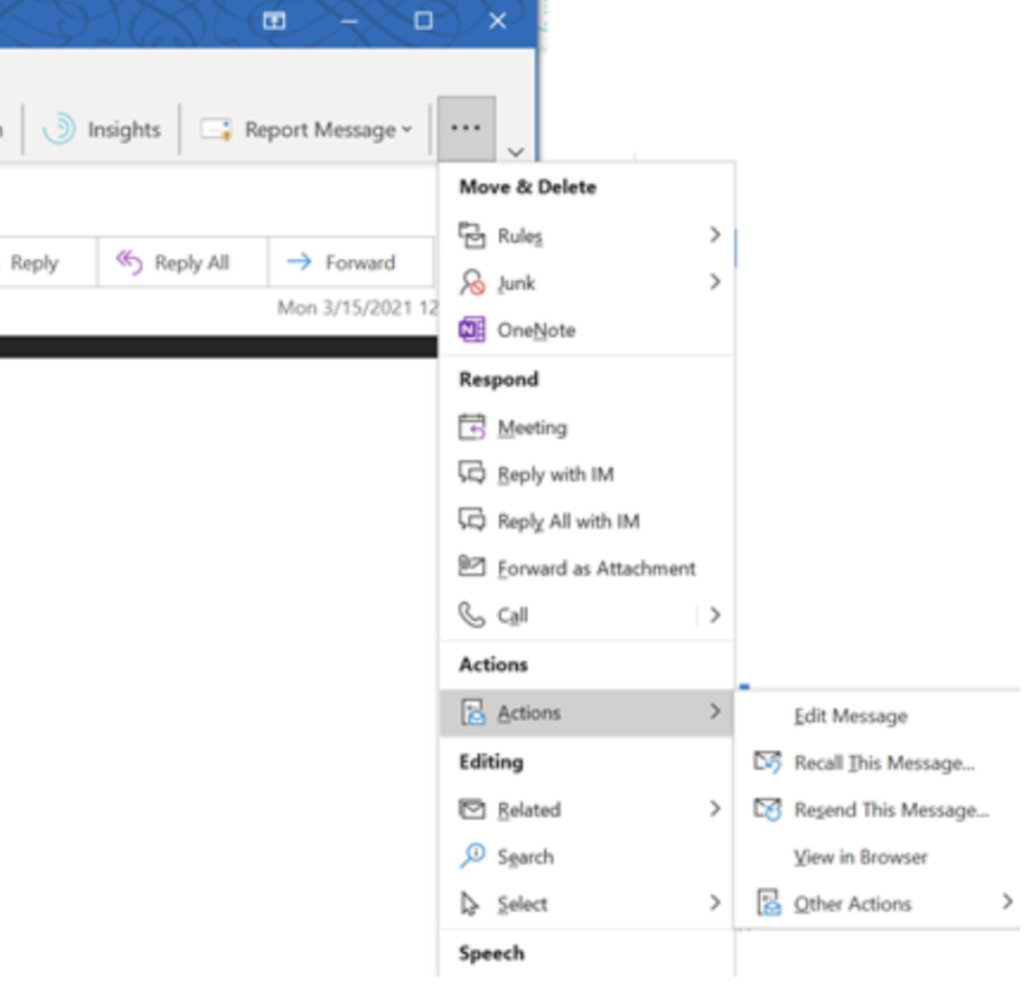
The limitations of this feature are that it only works only if both you and the recipient are using Microsoft Exchange (typically within the same organization) and that the recipient must not have read the email yet.
Recommended Read: How to Recall or Replace an Email in Outlook
3. Can I recover deleted emails in Outlook?
Recovering deleted emails in Outlook is a straightforward process, thanks to the built-in recovery features. Here’s how you can recover your deleted emails:
- Go to the “Deleted Items” folder in the left-hand pane of your Outlook interface. This is where deleted emails are initially moved.
- Browse through the deleted items to find the email you want to recover. Right-click on the email and select “Move” > “Inbox” (or any other folder where you want to move the email).

If you cannot find the email in the “Deleted Items” folder, it might have been permanently deleted. However, it can still be recovered from the “Recoverable Items” folder.
- In the left pane, select the Deleted Items folder.
- At the top of the message list, select ‘Recover items deleted from this folder’.

- Select the items you want to recover and select Restore.
4. How do I share my calendar on Outlook?
Sharing calendars in Outlook is a great way to coordinate schedules and ensure everyone is on the same page.
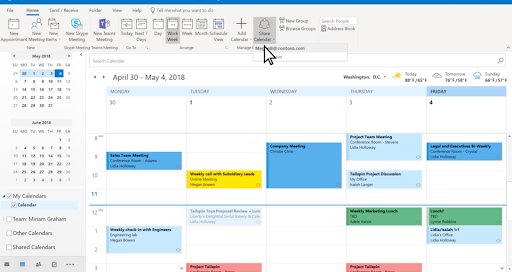
Here’s how you can share your calendar with others if you use the desktop app:
- Go to the “Calendar” view by clicking on the calendar icon at the bottom of the navigation pane.
- Click on the “Share Calendar” button in the “Manage Calendars” group. A new window will open. If you have multiple calendars, select the one you want to share from the drop-down menu.
- In the “Calendar Properties” window, click on the “Add” button. Enter the email address of the person you want to share your calendar with.
- Choose the level of access you want to grant. Options range from “Can view when I’m busy” to “Can edit.” Select the appropriate permission level for the recipient.
- Click “OK” to close the “Calendar Properties” window, then click “Send” to send the sharing invitation to the recipient.
This way, you can share your Outlook calendar, facilitating better collaboration and scheduling within your team and external contacts.
5. How to add a signature on MS Outlook?
Adding a signature to your emails in Outlook helps you present a professional image and provide your contact information.
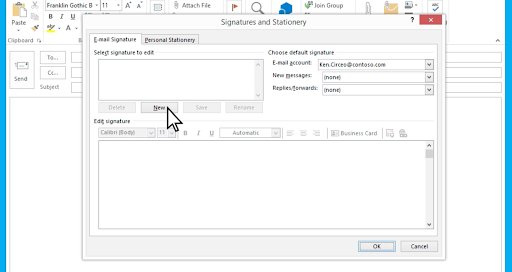
Here’s how you can create and add a signature in Outlook:
- Go to the “File” tab in the top-left corner of the window and select “Options” from the list on the left-hand side to open the Outlook Options dialog box.
- In the Outlook Options dialog box, select “Mail” from the list on the left. Click on the “Signatures” button in the “Compose messages” section. This will open the Signatures and Stationery window.
- In the Signatures and Stationery window, click on the “New” button to create a new signature. Enter a name for your signature and click “OK.”
- In the “Edit signature” box, type your desired signature. You can format the text using the available formatting options, such as font, size, color, and add images or links.
- Under “Choose default signature,” select the email account to which you want to apply the signature if you have multiple accounts. Choose the signature for new emails and replies/forwards from the respective drop-down menus.
- Click “OK” to save your signature and close the Signatures and Stationery window. Click “OK” again to close the Outlook Options dialog box.
6. How do I create a contact group in outlook?
Creating a contact group, also known as a distribution list, allows you to send an email to multiple contacts simultaneously. Here’s how to create a contact group in Outlook:
- In the “Home” tab, click on “New Contact Group.”
- Enter a name for your contact group in the “Name” field.
- Click “Add Members” in the “Contact Group” tab. You have several options to add members:
- From Outlook Contacts: Add members from your existing contacts.
- From Address Book: Add members from the global address list or other address books.
- New E-mail Contact: Add a new email address directly to the group.
After adding all the desired members, click “Save & Close.”
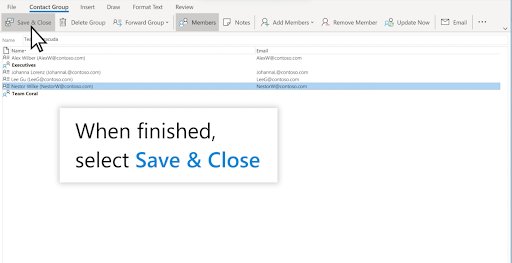
Your contact group is now created, and you can use it to send emails to multiple recipients at once by simply entering the group name in the “To” field of a new email.
7. How can I add or remove members from an existing contact group in Outlook?
- Locate the contact group you want to modify. You can search for the group by name in the search bar. Double-click on the contact group to open it.
- To add new members: click on the “Add Members” button in the “Contact Group” tab. Choose “From Outlook Contacts,” “From Address Book,” or “New E-mail Contact” to add new members. Select the new members you want to add and click “OK.”
- To remove members, select the member you want to remove from the list within the contact group window. Click on the “Remove Member” button in the “Contact Group” tab.
- After making the necessary additions or removals, click “Save & Close” to update the contact group.

By following these steps, you can efficiently manage the membership of your contact group to ensure it includes the correct recipients.
8. What is a Shared Inbox in Outlook and how does it work?
A shared inbox in Outlook allows multiple users to access and manage a common email account, making it easier for teams to collaborate on emails efficiently.
It’s commonly used in teams or departments where emails need to be accessible to several people, such as support or sales. Users with access to a shared inbox can perform tasks such as reading and responding to emails, managing the inbox, and organizing messages into folders.
Conclusion
Microsoft Outlook is a powerful tool that offers a range of features to streamline your email and calendar management. Whether you’re using Outlook as a standalone application or as part of the Microsoft 365 suite, understanding its functionalities can significantly enhance your productivity. I hope this post was able to clarify all your doubts about the tool.

































